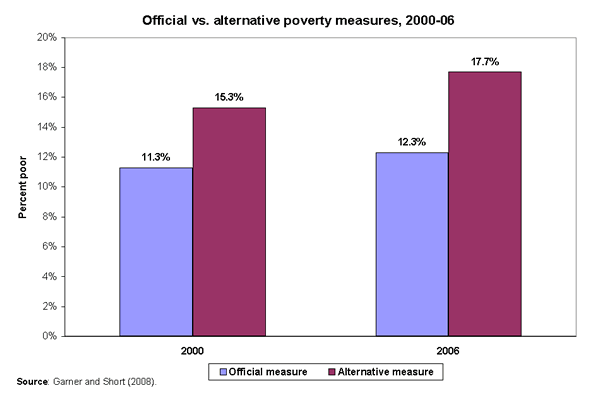See Snapshots archive.
Snapshot for July 2, 2008.
Official poverty measure undercounts the nation’s poor
In a few weeks, the U.S. Census Bureau will report on the 2007 poverty rate in America. Most likely, poverty as officially measured will have fallen slightly. But whatever the outcome, one thing is for sure: the official measure will represent a significant undercount of the nation’s poor. A more accurate measure would reveal that millions more persons face material deprivation.
The chart shows the official measure alongside a more accurate, alternative poverty measure taken from recent research that incorporates the recommendations of the National Academy of Sciences (see note). This alternative measure provides a much more detailed accounting of who is poor.
In both 2000 and 2006, the alternative measure is higher than the official measure. In 2006, 12.3% of the population—36.5 million people—were officially poor. But under the more comprehensive, alternative measure, 17.7% were poor—16 million more poor persons than under the official measure.
The trend in both measures is also revealing. Despite the fact that this was a productivity-rich recovery, the growth of income inequality over these years meant that income gains from the economy’s expansion failed to reach the lowest income families, and poverty rose under both measures. This lack of progress against the scourge of poverty amidst plenty stands as a stark reminder of the costs of inequality.
Note: The source for the alternative measure is Creating a Consistent Poverty Measure over Time Using NAS Methods, 1996-2005 by Thesia Garner and Kathleen Short (2008), The alternative measure for 2006 was kindly provided by the authors. Their alternative measure incorporates the recommendations of the National Academy of Sciences (NAS) from their extensive study of updating the official measure of poverty in America. The new measure counts many more income sources, including tax credits and the market value of food stamps. It also updates the poverty thresholds—the income levels used to determine poverty status—using up-to-date information on consumer spending, including housing and out-of-pocket medical costs. The official poverty measure can be found here.

